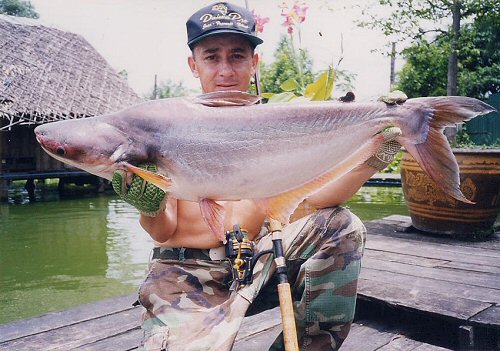SCOTCAT.COM
your internet guide to all things catfish
| Vietnamese River Cobbler |
by Daphne Layley |
Pangasius hypophthalmus
I asked the assistant behind the counter what sort of fish it was - “a Cobbler fish”, she replied – well, so much for their well known slogan - “Every Little Helps”. However, sitting at the computer later that evening, I typed “River Cobbler” into the Google search box and, guess what, it’s a catfish - Pangasius. It appears that they are farmed as a food fish in the Far East, where they are called Pangas, and apparently, as well as being very cheap, they are absolutely delicious. I was all fired up to go and buy some, until, delving further into the World Wide Web, I uncovered some rather chilling data about them, and I have copied here a few scary facts, for your information:- Pangas are teeming with high levels of poisons and bacteria, (industrial effluents, arsenic, and toxic and hazardous by-products of the growing industrial sector, polychlorinated biphenyls (PCBs), DDT and its metabolites (DDTs), metal contaminants, chlordane-related compounds (CHLs), hexachlorocyclohexane isomers (HCHs), and hexachlorobenzene (HCB)). The reasons are that the Mekong River is one of the most polluted rivers on the planet and this is where pangas are farmed and industries along the river dump chemicals and industrial waste directly into it. A laboratory test on these fish showed high amounts of contamination. Despite the reports and recommendations against eating Pangas, supermarkets are still selling them to the general public knowing they are contaminated. There’s nothing natural about Pangas - They’re fed dead fish remnants and bones, dried and ground into a flour, from South America, and also residue from soya and grains. This kind of nourishment doesn’t even remotely resemble what they eat in nature. But what it does resemble is the method of feeding mad cows (cows were fed cows, remember?) What they feed pangas is completely unregulated so there are most likely other dangerous substances and hormones thrown into the mix. The pangas grow at high speed - 4 times faster than in nature…so it makes you wonder what exactly is in their food? Pangas are Injected with Hormones Derived from Urine – I don’t know how someone came up with this one out but they’ve discovered that if they inject female Pangas with hormones made from the dehydrated urine of pregnant women, the female Pangas grow much quicker and produce eggs faster (one Panga can lay approximately 500,000 eggs at one time). Essentially, they’re injecting fish with hormones (they come all of the way from a pharmaceutical company in China) to speed up the process of growth and reproduction. That isn’t good. Some of you might not mind eating fish injected with dehydrated human pee but just consider the rest of the reasons to NOT eat it. Mmmm – maybe I’ll stick to fish fingers........ Reference & Data: dietmindspirit.org Read
more here on the: TIMESONLINE |
If you would like to contribute an article, please e-mail me. You will of course be credited for your work.
If you would like to donate any denomination of money to the site just click the above link button. All proceeds will go to running the site and hopefully to keep it going for a few years yet.
Print or e-mail this article below


